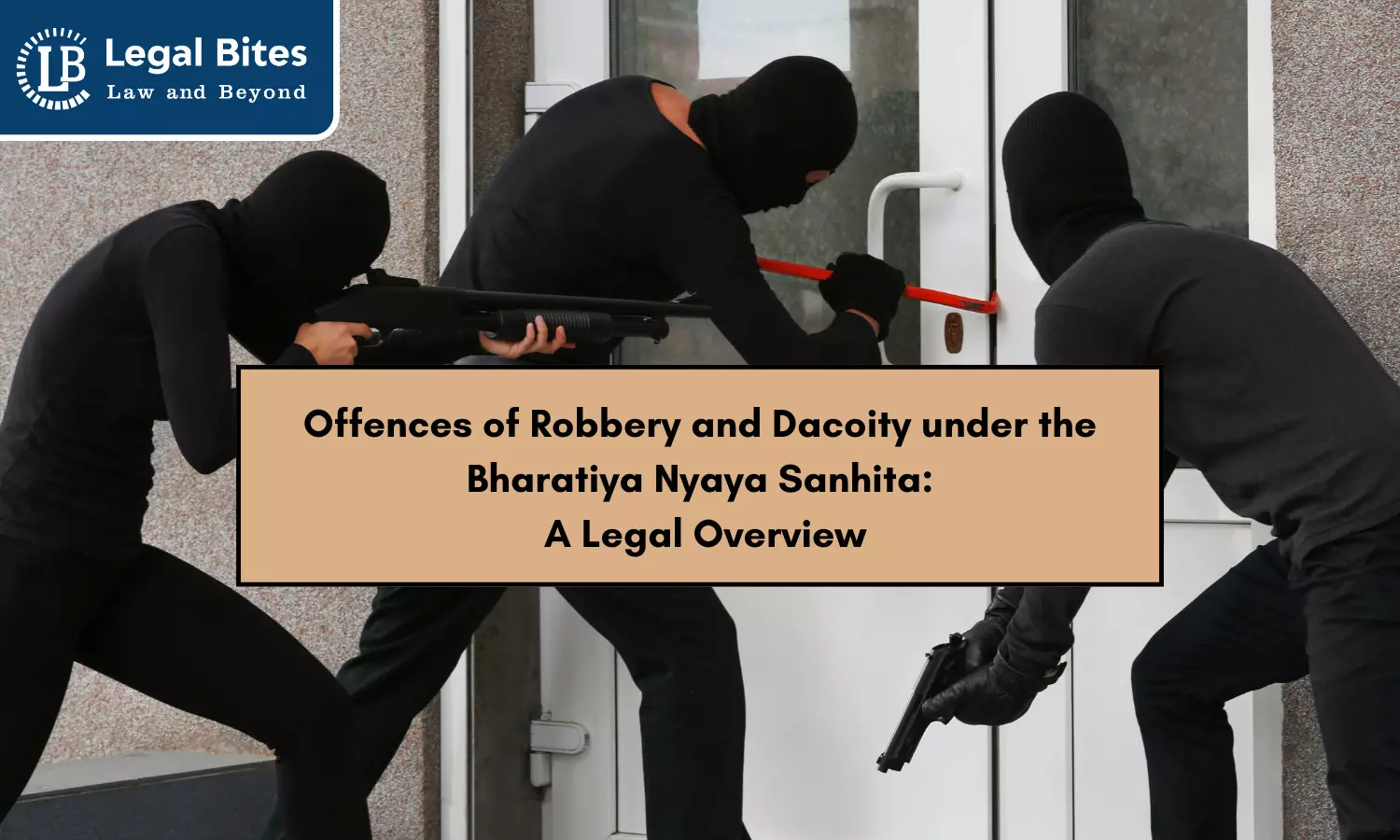Offences of Robbery and Dacoity under the Bharatiya Nyaya Sanhita: A Legal Overview
This article examines definitions, key elements, differences, and aggravated forms of robbery and dacoity under BNS, highlighting shifts from the IPC.

The criminal offences of robbery and dacoity strike at the heart of public safety and personal security. Recognised for their violent nature and the involvement of fear or threat, these crimes are dealt with severely under Indian criminal law. The Bharatiya Nyaya Sanhita, 2023 (BNS), which replaces the Indian Penal Code, 1860, retains and restructures these offences under Chapter XVII—"Of Offences against property," highlighting their serious nature.This article provides a...
The criminal offences of robbery and dacoity strike at the heart of public safety and personal security. Recognised for their violent nature and the involvement of fear or threat, these crimes are dealt with severely under Indian criminal law. The Bharatiya Nyaya Sanhita, 2023 (BNS), which replaces the Indian Penal Code, 1860, retains and restructures these offences under Chapter XVII—"Of Offences against property," highlighting their serious nature.
This article provides a comprehensive analysis of the offences of robbery and dacoity under the Bharatiya Nyaya Sanhita, 2023 (BNS). It delves into the statutory definitions, essential ingredients, and distinguishing features of both offences. The discussion further extends to their aggravated forms as laid down in Sections 311 to 313 of the BNS.
Additionally, the article highlights the significant jurisprudential and structural shifts brought about by the transition from the Indian Penal Code, 1860 (IPC), to the BNS, offering insight into how these changes impact the interpretation and enforcement of robbery and dacoity laws in India today.
Statutory Provisions under the BNS, 2023
1. Robbery – Section 309 BNS
Section 309 of the BNS defines "robbery" as a special, aggravated form of theft or extortion. According to this section:
Theft amounts to robbery if, for the purpose of committing the theft, or while committing it, or while carrying away or attempting to carry away the stolen property, the offender voluntarily causes or attempts to cause death, hurt, or wrongful restraint to any person, or induces fear of instant death, instant hurt, or instant wrongful restraint.
Extortion becomes robbery if:
- The offender intentionally causes immediate fear of death, hurt, or wrongful restraint to the victim or another person;
- The offender is present at the time — meaning close enough to instill such fear instantly; and
- The victim, due to that fear, is compelled to deliver the property or valuable security then and there.
Thus, robbery is an amalgamation of force + theft/extortion.
2. Dacoity – Section 310 BNS
Dacoity is said to be committed when five or more persons:
- Conjointly commit or attempt to commit a robbery, or
- Where the total number of persons committing, attempting, or aiding the robbery is five or more,
then each person involved in committing, attempting, or assisting is guilty of dacoity.
Essential Ingredients
Robbery:
- Presence of theft or extortion
- Use of violence or threat thereof
- Fear of instant harm or actual harm
- Act must be committed to facilitate theft/extortion or escape with the property
Dacoity:
- All ingredients of robbery.
- Conjoint action by five or more persons.
- Common intention or participation in the act or aiding it.
Difference between Robbery and Dacoity
| Feature | Robbery | Dacoity |
|---|---|---|
| Basic Concept | Aggravated theft or extortion | Robbery committed by five or more persons |
| Number of Offenders | May be committed by a single person | Minimum five persons must participate |
| Section | Section 309 BNS | Section 310 BNS |
| Punishment | Imprisonment up to 10 years + fine | Life imprisonment or 10 years + fine |
| Degree of Threat | High, but may involve individual force | Collective force or group intimidation |
Punishment for Robbery and Dacoity
Punishment for Robbery – Section 309(4), BNS
- Rigorous imprisonment up to 10 years and fine.
- If committed on a highway between sunset and sunrise: rigorous imprisonment up to 14 years.
Punishment for Dacoity – Section 310(2), BNS
- Imprisonment for life or rigorous imprisonment up to 10 years and fine.
Aggravated Forms
1. Attempt to Commit Robbery – Section 309(6) BNS
- Anyone who causes hurt while committing or attempting robbery, along with any accomplice, shall face life imprisonment or up to ten years of rigorous imprisonment, plus a fine.
2. Dacoity with Murder – Section 310(3) BNS
If any person of the dacoity gang commits murder during the act:
- Every member is punishable with death, life imprisonment, or rigorous imprisonment not less than 10 years.
This highlights the principle of constructive liability under group offences.
3. Making Preparation to Commit Dacoity – Section 310(4) BNS
Punishment:
- Rigorous imprisonment up to 10 years and fine.
Preparation alone is a punishable offence under BNS, emphasising the prevention-focused nature of the law.
4. Belonging to a Gang of Dacoits – Section 310(6) BNS
Anyone who habitually belongs to a gang of dacoits:
- Punishable with rigorous imprisonment up to 10 years and fine.
5. Receiving Property from Dacoity – Section 317(3) BNS
Whoever knowingly receives or keeps property obtained through dacoity:
- Punishable with imprisonment for life or rigorous imprisonment up to 10 years and fine.
6. Robbery or Dacoity with Deadly Weapon or Grievous Hurt (Section 311)
If, during robbery or dacoity:
- The offender uses a deadly weapon, or
- Causes or attempts to cause grievous hurt or death,
The punishment shall be rigorous imprisonment of not less than 7 years.
Attempted Robbery or Dacoity While Armed (Section 312)
- If a person attempts robbery or dacoity while armed with a deadly weapon,
He shall face rigorous imprisonment of not less than 7 years.
Habitual Association for Theft or Robbery (Section 313)
Anyone who is a member of a gang habitually engaged in theft or robbery (excluding dacoity),
- Shall be punished with rigorous imprisonment up to 7 years and liable to fine.
Robbery and Dacoity: IPC v. BNS at a Glance
Here is a comparative table of Robbery and Dacoity under the IPC and the BNS, 2023:
| Offence | IPC Section | BNS Section | Observations |
|---|---|---|---|
| Theft becomes Robbery | Section 390 | Section 309(1) | Same concept; structured in sub-clauses in BNS. |
| Extortion becomes Robbery | Section 390 | Section 309(2) | No change in essence; presented more clearly in BNS. |
| Explanation on proximity in robbery | Section 390 | Section 309(3) | Clarifies presence requirement; retained in BNS as sub-clause. |
| Punishment for Robbery | Section 392 | Section 309(4) | No change; incorporated without heading in BNS. |
| Attempt to commit Robbery | Section 393 | Section 309(5) | Content unchanged; incorporated as sub-section. |
| Robbery causing hurt | Section 394 | Section 309(6) | Retained with same punishment. |
| Definition of Dacoity | Section 391 | Section 310(1) | Same definition; formal change in structure only. |
| Punishment for Dacoity | Section 395 | Section 310(2) | Unchanged. |
| Dacoity with murder | Section 396 | Section 310(3) | Minimum 10 years' imprisonment made mandatory in BNS. |
| Preparation to commit Dacoity | Section 399 | Section 310(4) | Same as IPC; integrated into BNS structure. |
| Assembling for purpose of committing Dacoity | Section 402 | Section 310(5) | Same provision; no substantive change. |
This table captures the structural reorganisation and any slight modifications introduced in the BNS while keeping the essence of the IPC provisions intact.
Important Case Laws
[1] Venu @ Venugopal and Ors. v. State of Karnataka (2008)
The Supreme Court upheld the conviction and 10-year sentence of the appellants under Section 392 IPC (Section 309 BNS) for committing robbery on a public road at night. The accused had intercepted victims, tied them up, and robbed them at knifepoint, later being caught with stolen items and the vehicle.
The Court held that robbery, as defined under Sections 390 and 392 IPC (now Section 309 of BNS), includes theft or extortion with violence or threat of instant harm. It emphasised that highway robberies warrant deterrent punishment due to their grave social impact.
[2] Ram Shankar Singh And Ors. v. State of Uttar Pradesh (1955)
The Supreme Court set aside the conviction of the appellants under Section 395 IPC (now Section 310 BNS) after the High Court had acquitted three of the six accused. Noting that dacoity requires the involvement of at least five persons, and the charge did not mention any unidentified co-accused, the Court held the conviction legally unsustainable.
It further found that the prosecution failed to prove the individual roles of the remaining accused, and the evidence was unreliable due to prior enmity and inconsistencies. As the appellants had already undergone nearly three years of imprisonment, the Court declined to order a retrial and directed their release.
Socio-Legal Significance
Robbery and dacoity pose a serious threat not just to individuals but to public order and economic stability. The aggravated forms particularly aim to:
- Deter gang activity
- Penalise violent and armed robbery
- Empower police to act against dacoity rings even at the planning stage
Moreover, the BNS’s inclusion of preparation and gang membership as penal offences aligns with modern criminal jurisprudence, which emphasises preventive justice.
Conclusion
The Bharatiya Nyaya Sanhita, 2023 continues to address robbery and dacoity with seriousness and updated clarity. By streamlining provisions, enhancing penalties for aggravated forms, and aligning legal interpretations with evolving threats, the BNS reflects India’s contemporary criminal law priorities. However, effective enforcement, timely justice, and protection of rights remain critical to ensuring that the law not only punishes but also prevents such heinous offences.
References
[1] Bharatiya Nyaya Sanhita, 2023
[2] Indian Penal Code, 1860
[3] K.D. Gaur, Textbook on Indian Penal Code
[4] Venu @ Venugopal And Ors v. State of Karnataka AIR 2008 SC 1199
[5] Ram Shankar Singh And Ors. v. State of Uttar Pradesh AIR 1956 SC 441

Apurva Neel
I am a Research Associate and Editor at Legal Bites with an LL.M. specialization in Corporate and Commercial Laws from Amity University, Mumbai. I have put my best efforts into presenting socio-legal aspects of society through various seminars, conferences etc. I keep refining content as I am an ardent writer, and palpably law has got multi-dimensional aspect, so I passionately try to explore ahead.
